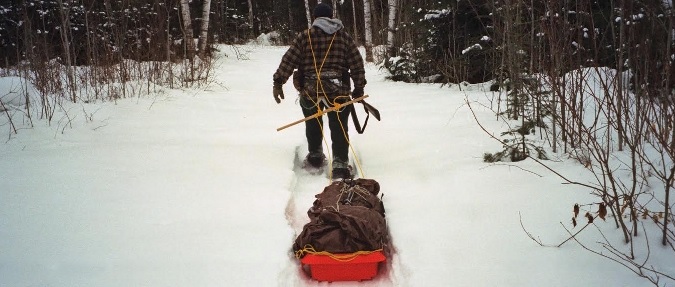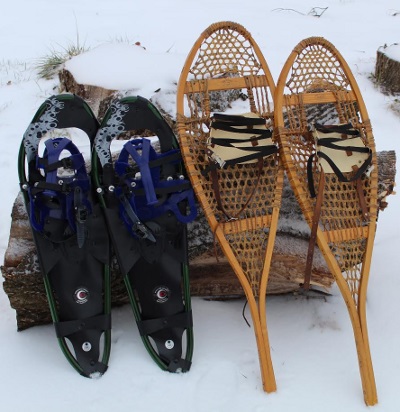Whether you are making your way across a frozen lake or pond to get to your tip-ups, running a trap line or just doing some winter hiking, if you partake in winter activities in the North Country then you need a pair of snowshoes. With a good pair of snowshoes you can get anywhere in the winter. You don’t need to worry about running out of gas or having the engine of a snowmachine scaring off wildlife. Best yet, the workout you get from using snowshoes is better than any gym membership.

I stated snowshoeing as a kid, back in a time when wooden snowshoes were the norm and not something that hung on the wall in someone’s ski lodge. My first pair of “shoes” was passed down to me from my aunt and they were already old when I got them. They were made by Faber, a company up in Canada. The webbing material is rawhide and the bindings were leather. Due to proper care the webbing is still in good shape, but the bindings had to be replaced. Those wooden shoes were heavy and since been retired; replaced by shoes made of more modern materials. My new snowshoes are made right here in the United States by Crescent Moon out of Colorado. I have the Gold 10 model which is their backcountry shoe and is rated up to 225 pounds. I like it because it comes complete with the crampons which make traveling on ice and crusted snow much easier.
Snowshoes have been around for over 4,000 years with the traditional webbed snowshoe being developed by Native Americans. My Abenaki ancestors used snowshoes for hunting, trapping and just for getting from one place to another during the long northern New England winters. They designed their snowshoes to mimic the traveling abilities of the animals that they hunted. Animals like snowshoe hare and lynx have no problem getting through the snow because of their wide feet. Some of those early snowshoe designs are still with us today for example the “beavertail”, “Huron” (named after the Native people who designed them) and the “bearpaw”. The original shoes were hand-crafted out of strong, yet flexible wood such as birch and ash. The webbing would have been made out of animal gut and the bindings out of moose or caribou hide. While these shoes made travel across deep snow efficient, they were, and are, very heavy. Thankfully things have changed.
Due to the availability of new materials, snowshoes have become lighter and more durable. Starting in the 1950s, snowshoes became smaller and lighter by using aluminum tubing, a popular method to this day. Animal gut and rawhide was replaced by nylon webbing, as were the bindings. Unlike wood, gut and rawhide, the new materials have a tendency to not stick to or collect the snow and ice, something that the old wooden shoes had a habit of doing which added to the weight as you traveled.
When choosing the right snowshoe you need to take a few things into consideration. First, is your shoe size and second is your weight. The larger the person, the larger the snowshoe you will need. Third, you need to consider the weight of the load you will be carrying. For example, the pack I normally carry is about 30 pounds, though I may carry up to 60 pounds depending on the situation. Last, but not least, you need to take into account the terrain you will most likely will be in.
Snowshoes work because they distribute weight (your weight and the load you are carrying) over a greater surface area. The more the weight is spread out, the less likely you will sink. This is the same process that makes a boat, or ship, float no matter its size. It is called displacement.
While snowshoes are often viewed as things used by the “New Age Group” who are looking to get back to the “wild”, they are valuable tools for those who hunt, ice fish and trap. They allow you access to the backcountry places that hold those things that we need. I carry mine wherever I go during the winter and so should you.
By Dana Benner
